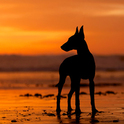Using canine instinct for workHere is a little collection of videos of dogs working in various capacities as they have done for thousands of years. Instead of the activities that you have probably seen already (luggage sniffing at the airport, police dogs, guide dogs, Schutzhund, etc), I have tried to find videos of dogs doing things that some people have probably not seen.
These dogs are all demonstrating some aspect of behavior that has been shaped through selection to serve a specific purpose. For example, the predatory behavior sequence has been broken up into stalking (border collie giving eye), chasing (Salukis running down an animal and killing but not eating it), heel-nipping to take down prey (moving livestock), and so on.
Other dogs have been selected to love pulling a sled and weather extreme conditions in the far north and in Antarctica. There is an extraordinary video of the last team of working dogs in Antarctica when all non-native animals were ordered to be removed. There is also a stunning and remarkable video about foxhounds, and don't miss feeding time. There is footage of the dogs used by nomadic herders in Mongolia, who pack up the ger and personal possessions and move periodically to follow forage seasonally for their animals. The Norwegian Lundehund (Puffin dog) is nearly extinct (currently in a cross-breeding program in the hopes of saving it), and it has anatomical features found in no other dog. Its ability to find Puffins in their nests deep in the rocks on the cliffs of Norway provided the food that got people in isolated villages through the long, dark winter. You will see the very different hunting styles of the Portuguese Podengo, Ibizan, Saluki, Finnish Spitz, English Pointer, Greek Porcelaine, Afghan hound, and Nova Scotia Duck Tolling Retriever.
When you watch these videos, appreciate that hundreds of years ago, these dogs were doing essential jobs that were necessary to survive and to put food on the table. The conditions were often extreme, and the dogs needed to be fit, functional, and worth their keep or they were culled.
Fair warning: There are hunting scenes and some dead animals as part of documenting the dogs doing the jobs there were bred for.
These dogs are all demonstrating some aspect of behavior that has been shaped through selection to serve a specific purpose. For example, the predatory behavior sequence has been broken up into stalking (border collie giving eye), chasing (Salukis running down an animal and killing but not eating it), heel-nipping to take down prey (moving livestock), and so on.
Other dogs have been selected to love pulling a sled and weather extreme conditions in the far north and in Antarctica. There is an extraordinary video of the last team of working dogs in Antarctica when all non-native animals were ordered to be removed. There is also a stunning and remarkable video about foxhounds, and don't miss feeding time. There is footage of the dogs used by nomadic herders in Mongolia, who pack up the ger and personal possessions and move periodically to follow forage seasonally for their animals. The Norwegian Lundehund (Puffin dog) is nearly extinct (currently in a cross-breeding program in the hopes of saving it), and it has anatomical features found in no other dog. Its ability to find Puffins in their nests deep in the rocks on the cliffs of Norway provided the food that got people in isolated villages through the long, dark winter. You will see the very different hunting styles of the Portuguese Podengo, Ibizan, Saluki, Finnish Spitz, English Pointer, Greek Porcelaine, Afghan hound, and Nova Scotia Duck Tolling Retriever.
When you watch these videos, appreciate that hundreds of years ago, these dogs were doing essential jobs that were necessary to survive and to put food on the table. The conditions were often extreme, and the dogs needed to be fit, functional, and worth their keep or they were culled.
Fair warning: There are hunting scenes and some dead animals as part of documenting the dogs doing the jobs there were bred for.

